11 Must-Watch Films for Divers & Ocean Enthusiasts
Explore the depths of the ocean from your screen with these 11 exceptional films ranging from powerful documentaries to cinematic classics. Each title offers a unique perspective on marine life,…
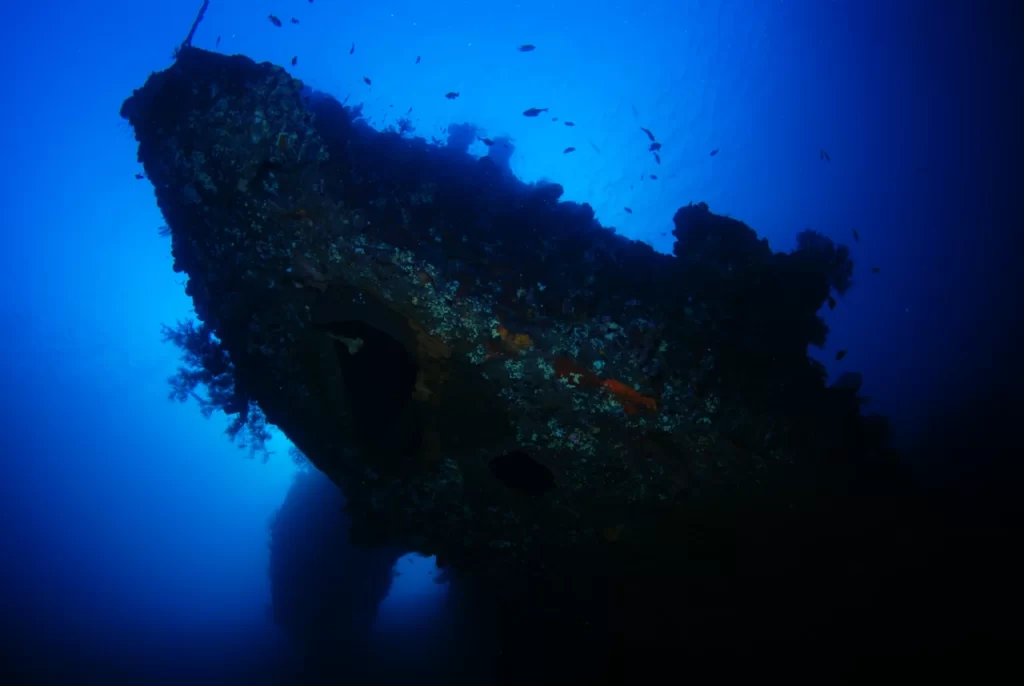
The USAT Liberty Shipwreck in Tulamben, Bali, is a fascinating piece of history. Torpedoed in 1942 during World War II and sunk by a volcanic eruption in 1963, it now supports over 400 fish species, located just 40 meters from shore. Bali Aqua Dive Center can help you visit, and this article explains the ship’s past, lists its underwater features, describes its marine life, and shows how to plan a dive. Interested in one of Bali’s top dive sites? Keep reading!!
The USAT Liberty Shipwreck, located in Tulamben, Bali, is a renowned dive site with a century-long history tied to global wars and natural events. Its transformation from a 1918 cargo ship to a dive attraction involves World War I, World War II, and a significant volcanic eruption. Below is a detailed account of why this 120-meter wreck rests 40 meters from Tulamben’s shore, a key destination for shipwreck diving.
In 1918, World War I prompted rapid shipbuilding in the United States. Federal Shipbuilding Company in Kearny, New Jersey, constructed the SS Liberty Glo, launching it on June 19 for the Emergency Fleet Corporation. The vessel, 125 meters long and 17 meters wide, had a 7,000-ton capacity for cargo such as horses, food, and munitions. A steam engine, fueled by coal or oil, powered a single propeller, operated by a crew of approximately 40. It served the Naval Overseas Transportation Service, delivering supplies until the war ended in November 1918.
Post-war, the Liberty Glo entered commercial service under operators like American Hampton Roads Line and Yankee Line, transporting grains and machinery across the Atlantic. It encountered incidents: in 1929, near Brest, France, it collided with a small boat in fog, sinking it and causing two fatalities. In 1933, it struck the SS Ohioan off New York, grounding the other ship. Its durable hull sustained it, and by 1939, the US Maritime Commission oversaw its commercial routes.
World War II altered its purpose. In November 1940, the US Army requisitioned it as USAT Liberty to carry supplies including rubber, railway parts, canned goods, and bullets to Pacific allies. Painted gray for camouflage, it sailed from San Francisco. In early 1942, it departed Australia for the Philippines, loaded with rubber and railway components, navigating the Dutch East Indies, now Indonesia.
On January 11, 1942, a critical event occurred. While passing through the Lombok Strait between Bali and Lombok, Japanese submarine I-166 fired a torpedo at approximately 4:30 AM. The torpedo hit the starboard engine room, causing severe flooding. No crew members were lost, but the ship was heavily damaged. Allied destroyers, USS Paul Jones and Dutch Hr.Ms. Van Ghent, attempted to tow it to Singaraja, a northern Bali port, to salvage its cargo. Excessive water intake forced the crew to beach it at Tulamben on January 14, 1942, with the bow on sand and stern in shallow water.
For 21 years, the Liberty remained on Tulamben’s black-pebble beach, becoming a local landmark. Villagers salvaged metal for tools and homes, removing guns, anchor chains, and fittings. Rust spread, paint peeled, and exposure to Bali’s sun weathered it, integrating it into the coastal landscape, often visited by fishermen and children.
In 1963, Mount Agung, Bali’s 3,142 meters volcano, erupted after decades of dormancy. Seismic activity began in February, escalating to a March 17 eruption that killed over 1,500 people and devastated villages. Lava flows and tremors altered Tulamben’s coastline. Between March and May, the Liberty slid into the sea, fracturing into sections. It settled on its starboard side, parallel to the shore, at depths ranging from 3 to 30 meters, establishing it as a dive site.
Coral growth accelerated post-1963, facilitated by the hull’s rusted state, stripped of marine paint during its beach years. By the 1980s, divers observed extensive hard and soft corals, with fish like snappers and eels inhabiting the structure. Today, over 400 species, including barracudas and nudibranchs, populate the wreck, cementing its status as a premier Bali dive site. Its historical significance attracts divers globally.
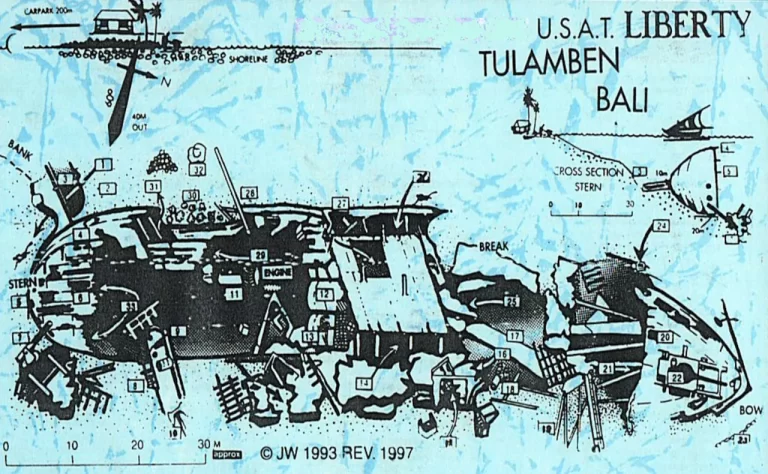
The USAT Liberty Shipwreck, located 40 meters from Tulamben’s shore, spans 120 meters and depths of 3 to 30 meters, offering multiple features for divers. Below are the primary areas to explore during a Tulamben diving trip, a highlight among Bali dive sites.
The wreck’s steel framework supports extensive coral coverage, including hard corals like brain and mushroom types, soft corals, yellow and red sponges, and sea fans. Additional structures include scattered deck plates near the stern, rusted railings along the break, and partial hull panels in the cargo holds, all colonized by marine growth. These features make the Liberty a central destination for shipwreck diving, with varied depths and points of interest for all diver levels.
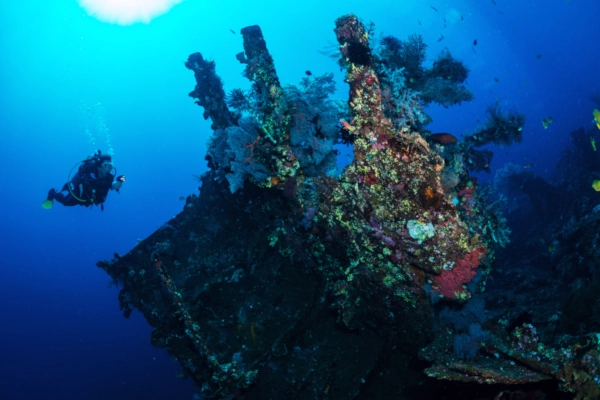
The USAT Liberty Shipwreck supports over 400 fish species, forming a dense ecosystem across its structure. Below is a detailed list of marine life observed during dives, a major draw for Tulamben diving and Bali dive sites.
Fusiliers and snappers school in groups of dozens around cargo holds and the break, feeding on plankton. Parrotfish consume corals in the stern and bank, butterflyfish swim in pairs near sea fans, and gobies hide in crevices throughout the wreck. Moray eels, including green and spotted varieties, occupy the engine room and artillery section. Turtles, mainly hawksbill, are seen near the bow, grazing on sponges.
Macro species include seahorses, frogfish, and nudibranchs in colors like blue and orange, located on the bank and surrounding reef. Barracudas patrol the bow in small groups, while trevally schools move through deeper areas like the artillery section. Sweetlips congregate in cargo holds, often in clusters of 10 or more. Angelfish and triggerfish swim near the stern, and juvenile batfish hover around the bank. These species are active during daylight, providing varied sightings.
Bioluminescent plankton is visible with water movement across the wreck. Spanish dancers, a red sea slug species, appear in cargo holds and near the break. Flashlight fish, small and glowing, swim in the engine room and darker passages. Shrimps and crabs, including cleaner and hermit varieties, emerge from corals at the stern and bank.
Parrotfish rest in mucus cocoons in the cargo holds, lionfish hunt around the bank with spread fins, and basket stars extend across corals to feed, mainly near the stern. Moray eels remain active, hunting in the artillery section. Pufferfish and boxfish settle near the surrounding reef, and nocturnal cardinalfish school under ledges in the break. Night dives reveal species less common during the day.
The USAT Liberty Shipwreck, 40 meters from Tulamben’s beach, ranges from 3 to 30 meters in depth. Water temperatures are 26-30°C (79-84°F), with visibility of 15-25 meters, making it a top choice for shipwreck diving. Below are comprehensive details on diving procedures, options, and recommendations for a Tulamben diving experience.
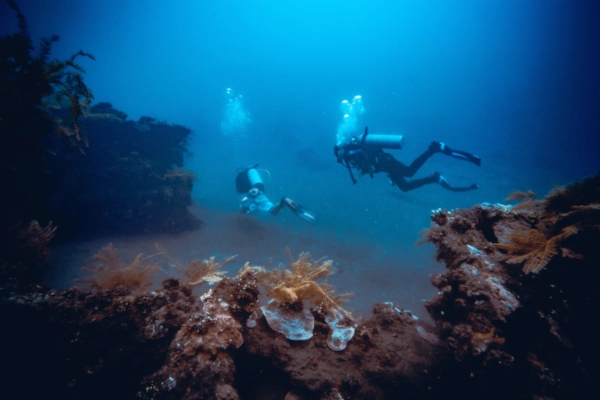
Divers begin on Tulamben’s black-pebble beach, where local staff assist with gear setup and transport tanks to the water’s edge. Entry involves walking over pebbles into shallow water, followed by a 40-meter swim to reach the wreck. Beginners focus on the stern at 3-12 meters, where corals and small fish are abundant.
Advanced divers explore the bow or artillery section at 25-30 meters for larger species. A thin wetsuit or rash guard is adequate for warmth. Guides provide pre-dive briefings, covering safety protocols and wreck layout, and lead groups to specific features like the engine room, cargo holds, or bank. Dives typically last 45-60 minutes, depending on air consumption and depth. Surface intervals occur on the beach, with shade and water available from nearby vendors, restaurant or cold box from your dive center.
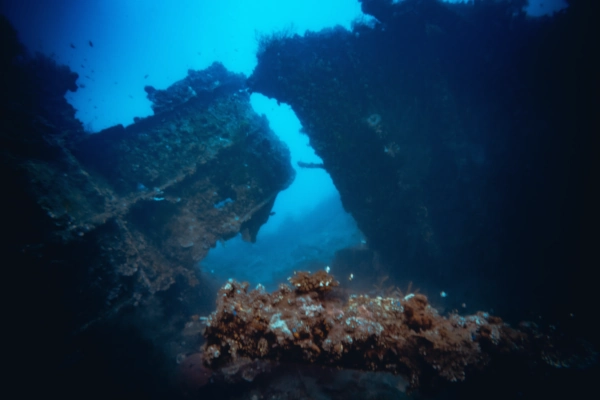
Ready to dive the USAT Liberty Shipwreck? Bali Aqua Dive Center, based in Sanur, organizes daily trips to make it happen. Contact Bali Aqua now to secure your spot for a Tulamben diving experience and explore one of Bali’s top dive sites.
August to September offers the clearest water, with visibility often exceeding 20 meters. April to October provides reliable conditions, with 8-9 AM dives ensuring calm seas and minimal crowds. October to March sees occasional rain but remains suitable for diving the Liberty year-round, offering a quieter experience with fewer divers.
Tulamben is in Kubu, Karangasem Regency, Bali 80852 (code: PHGV+867). Bali Aqua Dive Center in Sanur coordinates daily trips from South Bali. Free pick-up is included for guests in Sanur, Nusa Dua, Denpasar, Kuta, Legian, or Seminyak. For those in Ubud, Uluwatu, or Canggu, a small additional transport fee applies, ensuring access from most tourist areas.
Beginners can join Discover Scuba Diving for 2,150,000 IDR, guided in small groups of up to two for personalized attention. Certified divers can book fun dives for 1,850,000 IDR, covering multiple wreck explorations. Both options include pick-up from South Bali, lunch, a towel, dive equipment, and tax.
Equipment provided includes tanks, weights, regulators, buoyancy control devices, masks, fins, and wetsuits, all maintained to safety standards. Guides are certified professionals, ensuring clear communication and support, especially for non-fluent English speakers. Book your Bali dive site trip with Bali Aqua today to dive the Liberty with ease.
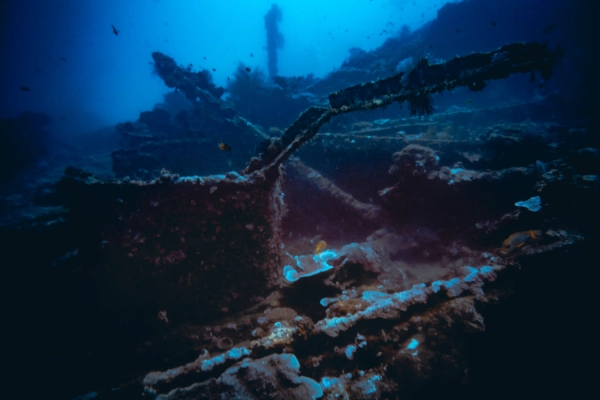
Extend your trip with other Tulamben dive sites: Boga Wreck at 14-30 meters, featuring a sunken ship with corals; Seraya for macro species like nudibranchs and shrimps; Coral Garden at 5-10 meters, with colorful reefs; and Tulamben Drop-Off, reaching 70 meters for advanced divers seeking dramatic walls. Bali Aqua can arrange these dives to complement your Liberty wreck experience, maximizing your time in one of Bali’s premier diving regions.
If you want to check the second best place to dive in Bali, check description and map of Nusa Penida & Nusa Lembongan dive sites.
The USAT Liberty Shipwreck in Tulamben is a unique blend of World War II history and a thriving reef ecosystem, supporting over 400 fish species across its 120-meter structure. From its construction in 1918 to its torpedoing in 1942 and final sinking in 1963, it stands as a testament to resilience and nature’s transformation, making it a flagship Bali dive site. Whether you’re a beginner curious about underwater exploration or a certified diver seeking diverse marine life, the Liberty offers accessible depths from 3 to 30 meters.
Dive with Bali Aqua Dive Center for a seamless experience: fun dives at 1,850,000 IDR or Discover Scuba Diving at 2,150,000 IDR, both including pick-up from South Bali, lunch, towel, equipment, and tax. The wreck’s coral-covered features, from the shallow stern to the deeper bow, provide options for wreck diving, macro photography, and night dives, ensuring something for every skill level. Nearby sites like Boga Wreck and Tulamben Drop-Off add variety to your itinerary. Ready to explore one of the world’s easiest and most rewarding shipwreck dives? Book your Tulamben diving adventure with Bali Aqua now and discover why the Liberty draws divers globally to Bali’s northeast coast.
Explore the depths of the ocean from your screen with these 11 exceptional films ranging from powerful documentaries to cinematic classics. Each title offers a unique perspective on marine life,…
Bali, occasionally raises concerns about shark attacks among ocean enthusiasts. While the island’s waters are home to various shark species, incidents involving humans are exceedingly rare. This article delves into…
Bali and its surrounding islands offer scuba divers the thrill of encountering a surprising variety of shark species. From tranquil coral reefs patrolled by reef sharks to rare appearances of…
PADI Advanced Open Water Diver Course The advanced open water diver course has 5 dive specialties to choose. Two are chosen for you, Deep and Navigation, the other three are…
Explore the depths of the ocean from your screen with these 11 exceptional films ranging from powerful documentaries to cinematic classics. Each title offers a unique perspective on marine life,…
Bali is a dream destination for scuba divers of all levels. With clear waters, vibrant coral reefs, and a wide range of marine life, it’s no surprise that divers from…
The Nusa Penida MPA has an official Manta Ray Code of Conduct outlining how divers and snorkelers should behave around these gentle giants. By following this code, you not only…